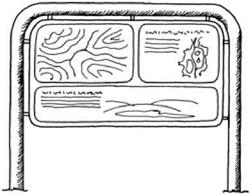This is frequently the most common material, used either in the round or as sawn components. Round timber should be straight, cylindrical, of low taper and debarked. Large dimensions work best, especially in forests of big conifer trees. Upright poles with horizontal cross-members provide a simple framework. Panels are fixed onto this by recessed bolts, whose holes can be plugged to hide the nuts and tidy the end result.
In most other circumstances sawn wood, either hard or soft, is used. Once again, sturdy, well-proportioned members jointed simply with good workmanship are better than fussy composite units. Some recent examples include pairs of upright flat slabs between which panels are fixed using diagonal slots and hidden threaded rods with nuts at both ends. The fewer components there are, the better. This example has three.
Recent techniques use slabs of timber, singly or in groups, carrying routed or sandblasted messages. These look simple and unfussy in a wide range of settings, and require much less maintenance.
|
Tubular steel, either galvanized or of the ‘Cor-ten’ rusting type, can make a strong frame. A panel can be bolted to flanges fixed to the tubing. |
The choice of timber to be used will partly depend on what is available, perhaps from sources nearby, and on its durability. Many species of tree are not durable in contact with the ground. Spruce, some pine, hemlock, birch, poplar, beech and ash are not durable, whereas cedar, oak, larch heartwood and chestnut are naturally durable. Many other species, especially pine and fir, are ideal when pressure treated. The chemicals used in pressure treatment—copper, chrome and arsenic—might not be appropriate, or might be considered unsustainable in some environments. A compromise might be to treat only those parts in contact with the ground. The rest of the wood can be left to weather and blend into the surroundings, or can be stained. There are a wide range of coloured wood stains on the market, many of which are of suitable colours to blend with different landscapes.




